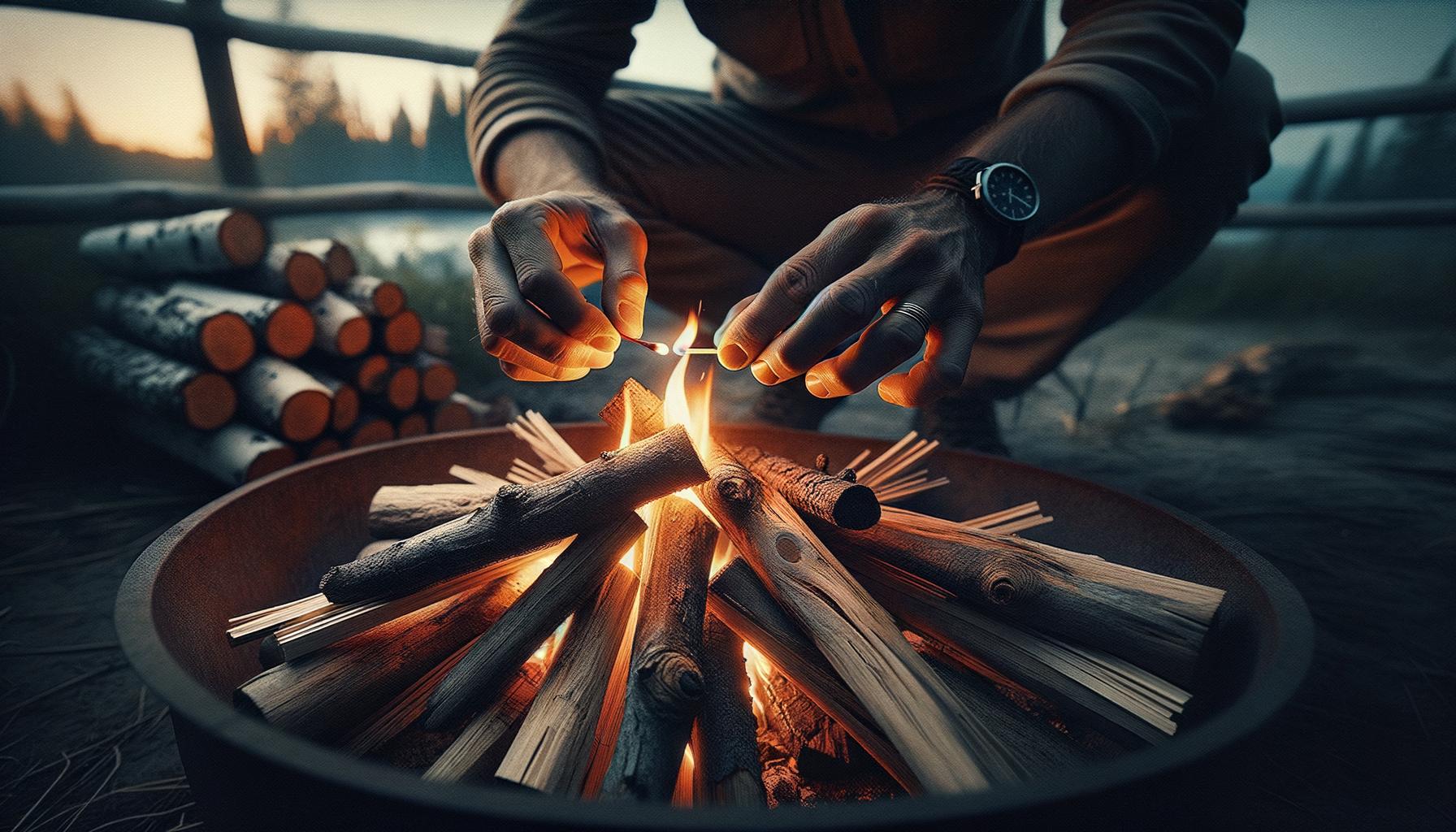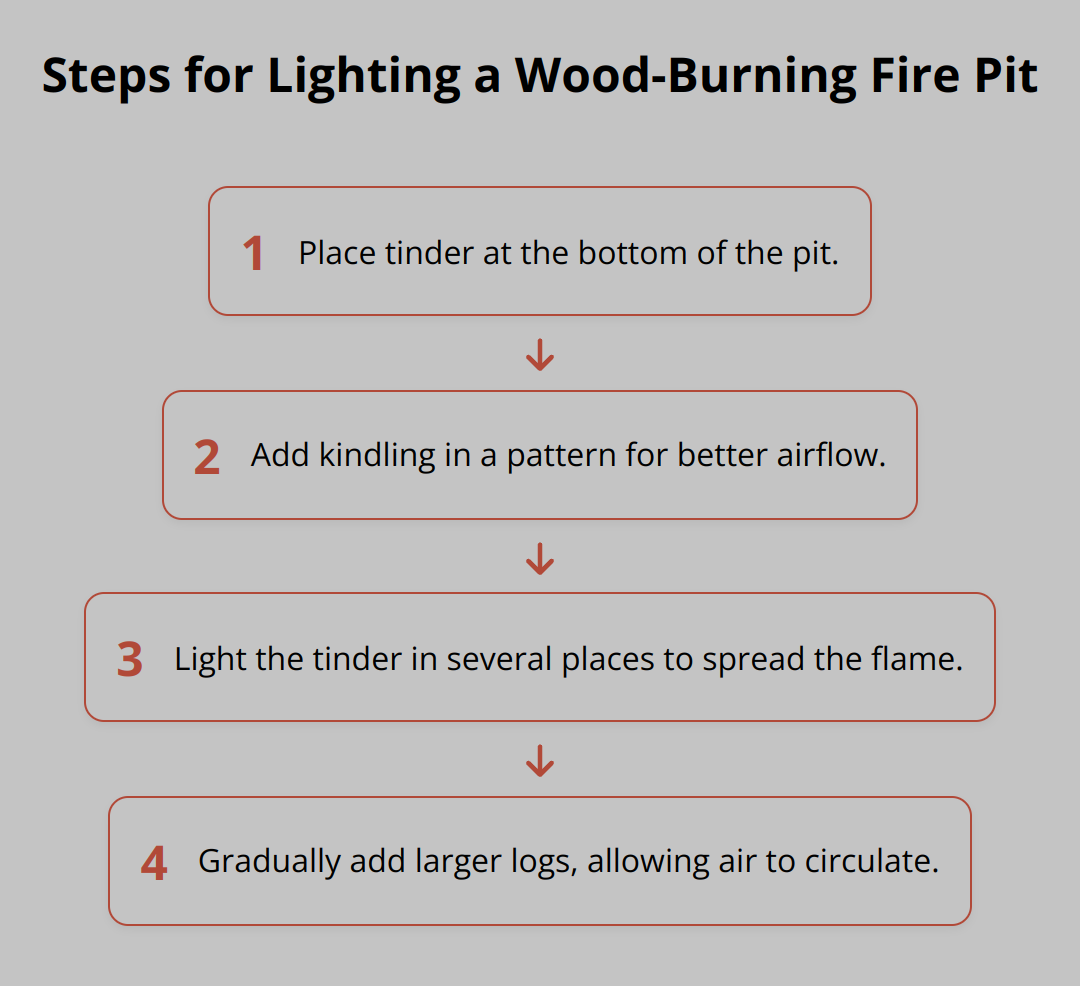
We at S&S Fire Pits believe in the power of gathering around a warm, inviting flame. Mastering fire pit lighting techniques is essential for creating memorable outdoor moments.
In this blog post, we’ll guide you through choosing the right fuel, preparing your fire pit area, and lighting your fire pit safely. Let us help you enhance your outdoor experience with confidence and ease.
Choosing Your Fire Pit Fuel
Selecting the perfect fuel for your fire pit is more than just a matter of preference; it directly impacts the ease of use, maintenance, and the overall ambiance of your outdoor gathering space. Let’s explore the essentials to ensure your fire pit sessions are both enjoyable and efficient.
Wood – The Classic Choice:
Wood is the heart and soul of traditional fire pit experiences. Not only does it provide a crackling sound and a mesmerizing flame, but it also offers versatility in terms of the aromatic scents depending on the wood type. Hardwoods like oak, hickory, and ash burn longer and hotter, making them ideal for fire pits. Softwoods, while easier to ignite, tend to burn faster and should be used sparingly as starter material or for shorter fire sessions. Remember, using seasoned wood minimizes smoke and prevents the buildup of creosote that can hinder your fire pit’s performance.
Gas – Modern Ease and Control:
For those looking for a cleaner and more controlled burning option, natural gas and propane fire pits are unbeatable. They eliminate the need for constant refueling and the mess associated with wood ashes. With the flip of a switch, you can have instant flames and an easily adjustable fire intensity. This convenience, however, comes at the cost of missing out on the traditional fire pit feel, including the wood-burning scent and sound.
Practical Tips:
- Always ensure your chosen fuel is suitable for your specific fire pit model.
- For wood-burning pits, maintain good kiln dried firewood for longer burn and almost no smoke.
- Consider the availability and cost of natural gas or propane in your area before investing in a gas fire pit.
- Explore eco-friendly fuels for an environmentally conscious choice that doesn’t sacrifice the joy of a warm fire.
Selecting the right fuel for your fire pit sets the stage for countless memorable nights. Whether you cherish the traditional crackle of wood, the convenience of gas, or the green credentials of eco-friendly alternatives, make your choice with both practicality and preference in mind. For more on the benefits of wood and gas fire pits, check out our detailed exploration wood and gas fire pits benefits.
By considering these key factors, you’re well on your way to becoming a master of fire pit lighting, ready to ignite not just flames, but lasting memories.


Preparing Your Fire Pit Area
Preparing your fire pit area with safety and efficiency in mind is a step you cannot afford to overlook. Proper setup ensures not only the longevity of your fire pit but also the safety of everyone around it. Here’s how you can do it right.
Clearing the Space
First off, select a level surface for your fire pit that’s at least 10 feet away from any structures, trees, or flammable materials. This distance is minimum; more is always better. Clear away any debris, dry leaves, or anything that can catch fire. For those with wood decks, investing in a fireproof mat underneath your pit is wise to prevent heat damage.
Gathering Tools and Materials
Having all your tools and materials at hand before you start is key to a smooth experience. You’ll need:
- A lighter or matches
- Fire starter, if available
- Kindling
- Seasoned firewood or your chosen fuel
- A bucket of water or a garden hose nearby, for emergencies
These essentials streamline the process of starting your fire, allowing you to focus on enjoying the experience rather than scrambling for supplies after the fact.
Safety Gear and Precautions
Never underestimate the importance of safety gear. Gloves protect your hands from burns and splinters, while safety glasses shield your eyes from sparks. If you’re going to be moving large logs or working close to the flames, these are non-negotiables.
It’s also essential to have a plan for extinguishing your fire pit. A bucket of sand, water, or a fire extinguisher should always be within arm’s reach. Better safe than sorry.
Practical Tips
- Check the wind direction before you light your fire. Avoid lighting your pit on excessively windy days as it can blow sparks and embers toward flammable materials.
- Inform everyone in your household about the fire pit rules. This is especially important with children or pets around.
- For more detailed safety tips, read our guide on fire pit safety.

By taking these steps to prepare your fire pit area, you’re not just ensuring a safer environment; you’re setting the stage for countless enjoyable nights by the fire.
Lighting Fire Pits Correctly
For the ultimate outdoor experience, mastering the art of lighting your fire pit correctly is essential. Whether you’re gathered around a traditional wood-burning fire pit or enjoying the convenience of a gas fire pit, the right lighting techniques can make all the difference. Here, we’ll share practical advice on how to effectively light different types of fire pits and maintain a consistent flame.
Mastering Traditional Wood Burning Fire Pits
Lighting a wood-burning fire pit is an art in itself, combining tradition with a touch of skill. Begin by gathering your materials: seasoned hardwood, tinder, kindling, and a lighter or matches. The key here is preparation and layering.
- Start by placing tinder at the bottom of your fire pit. Options like dry leaves, pine needles, or newspaper work well.
- Add kindling in a criss-cross pattern or a pyramid atop the tinder. This allows for better airflow, which is critical for ignition.
- Light the tinder in several places to spread the flame evenly. As the kindling catches fire, carefully add more until you have a strong flame.
- Gradually add your larger logs to the fire, positioning them to allow air to circulate. This will ensure a steady, hot flame perfect for those cozy nights outdoors.

Remember, keeping your fire going requires periodic maintenance. Add logs as needed but avoid overloading to prevent smothering your fire.
Gas Fire Pits: Safety and Lighting
Gas fire pits offer convenience and ease of use unmatched by traditional wood-burning pits. Safety, however, is paramount. Always check connections for leaks by applying a soapy water solution along the gas line and connections. If bubbles form when you turn the gas on, there is a leak, and you should not light the pit until it’s fixed.
For lighting:
- Open the gas valve on your fire pit.
- Use a long lighter or electronic ignition to light the pit while standing to the side to avoid any flare-up.
- Once lit, adjust the gas flow to achieve the desired flame height and warmth.

The beauty of a gas fire pit lies in its control. You can easily adjust the flame to suit your needs, whether you’re looking for ambiance or warmth.
Tips for Maintaining a Consistent Flame
- Ventilation is key. Whether it’s a wood-burning or gas fire pit, ensuring proper airflow is essential for a consistent flame.
- Fuel quality matters. For wood-burning pits, use seasoned hardwood. For gas fire pits, ensure your propane tank is full and the gas line unobstructed.
- Regular cleaning. Remove ash and debris from wood-burning fire pits to improve air circulation. For gas fire pits, ensure burners are clean for optimal performance.
By following these practical steps, you will enjoy a beautiful, safe flame in your backyard sanctuary. Every fire pit requires attention to detail, from preparation to lighting and maintenance. Embrace these tasks as part of the ritual of fire pit enjoyment, enhancing the overall experience for you and your guests. Whether opting for the rustic charm of a wood fire or the modern convenience of a gas pit, correctly lighting and maintaining your fire pit is the cornerstone of memorable outdoor gatherings.
For more detailed safety tips, especially for wood fire pits, explore our guide on managing a fire.
Wrapping Up
Mastering fire pit lighting techniques is an essential skill for enhancing your outdoor living space. We at S&S Fire Pits have guided you through selecting the right fuel, preparing your fire pit area, and safely lighting your fire pit. The journey doesn’t end here; it’s just beginning. Safety and preparation are paramount, ensuring a hassle-free, enjoyable experience around your fire pit.

Remember, whether opting for the crackling ambiance of wood or the convenience of gas, the correct approach to lighting and maintenance can dramatically enhance the quality of your gatherings. The importance of using seasoned wood, ensuring proper gas connections, and regular cleaning cannot be overstated. These elements are critical for maintaining a consistent and safe flame.
We encourage you to experiment within the safe parameters set out in this guide. Each fire pit session is an opportunity to refine your techniques and create more memorable moments. Whether you’re looking to enjoy a quiet evening under the stars or hosting a lively gathering with friends, the warmth and ambiance of a well-maintained fire pit can make all the difference.
Your fire pit is more than just a source of warmth; it’s a centerpiece for connection and outdoor enjoyment. With S&S Fire Pits’ handcrafted, solid steel fire pits, quality and durability are guaranteed, ensuring countless nights of enjoyment. Explore our range of fire pits and accessories to find the perfect centerpiece for your outdoor space. Remember, the right preparation, safety practices, and a bit of patience are all you need to master the art of fire pit lighting. Go ahead, light up your backyard and create unforgettable outdoor experiences.


